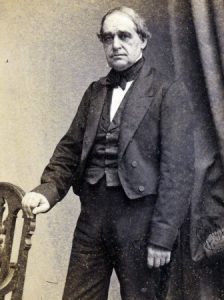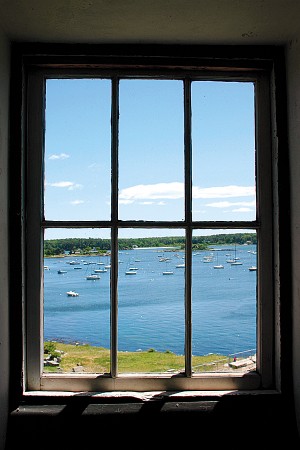Forts: The vice president toted a rifle at Fort McClary
One night during summer 1864, Pvt. Hannibal Hamlin prevented a drunken soldier from shoving his way into Fort McClary in Kittery, Maine. The private’s civilian occupation as vice president of the United States did not deter his inebriated comrade from hurling verbal abuse, but certainly affected the drunk’s punishment.

Colonial-era defenses once occupied the Kittery Point site selected for the Second System fortification that officially became Fort McClary in 1808. Named for New Hampshire’s Maj. Andrew McClary (dismantled by a British cannonball at the battle of Bunker Hill), this fort and Fort Constitution in Newcastle, New Hampshire guarded the Piscataqua River entrance during the Civil War.
With Maine’s existing militia companies merged into various active-duty infantry regiments in 1861, the legislature created the Maine State Guards to provide wartime military service within the state. The various companies formed the 1st Regiment Light Infantry.
Bangor got Co. A, “composed of Bangor men,” wrote Charles Eugene Hamlin, the vice president’s grandson. Hannibal Hamlin and many social peers quickly enlisted and for the next few years donned their uniforms and toted their rifles during funeral processions for slain officers, such as Maj. Gen. Hiram Berry.

By spring 1863 Capt. Llewellyn J. Morse (a 1st Maine Cavalry veteran) commanded and routinely drilled Co. A, and Hannibal Hamlin turned out whenever home from Washington.
Company B, 1st New Hampshire Heavy Artillery, garrisoned Fort McClary from autumn 1863 to early May 1864. Then the War Department transferred the Granite Staters to various District of Columbia forts vacated by heavy artillery regiments sent to reinforce the Army of the Potomac.
The War Department mustered Co. H, Maine State Guards (“consolidated with a detachment of Company G”) at Fort McClary on April 27. That detachment mustered out on July 9.
Sometime earlier Morse had received notice that Co. A would garrison Fort McClary that summer. Learning that the vice president planned “to march with his comrades,” the captain and other soldiers figured Hamlin did not realize that his political status could exempt him from active duty.
“It was not necessary for him to go — he was the Vice-President,” Charles Eugene Hamlin explained.
Hannibal Hamlin would have nothing of it. “I am Vice-President, but I am also a private citizen, and as an enlisted member of your company, I am bound to do my duty,” he informed Morse. “I aspire only to be a high private in the rear ranks, and keep step with the boys in blue.”
Mustering at Bangor on July 7, Co. A traveled by train to southern Maine and occupied McClary. “Performing all the duties” required “of the private soldier,” Hannibal Hamlin only acquiesced to one Morse request: that he “quarter with the officers.”1
The State Guards lived an idyllic existence, according to a uniformed correspondent pseudonymed “Thomas Cod.” Located “about three miles below the Navy Yard,” Fort McClary occupied “one of the most lovely spots to be found along our coast, and none more healthy or desirable can be found for a summer residence.”
The State Guards were “well quartered in the barracks, and while it is not home life, they are comfortable,” Cod reported.2
In appointing Hamlin company cook, More likely knew the vice president was an avid and cagey fisherman with favorite fishing holes scattered around the state. Turning a blind eye, the captain “lowered his standards of military discipline on several occasions” to let Hamlin go fishing along the Piscataqua River.
He supplemented the military fare by catching “Cod, Haddock, Hake, Cunners & Mackerel,” he informed his wife, Ellen Vesta Hamlin.
While on sentry duty one night, Hamlin challenged “a young private, who was very drunk” while returning to Fort McClary. When the soldier failed to provide “the countersign,” Hamlin denied him passage. So pickled that he did not recognize the vice president, the drunkard “abused him outrageously, and made such a scene that the corporal of the guard heard him,” Morse later related the incident to Charles Eugene Hamlin.

Tossed into the guard house, the drunkard awakened “the next morning” to greet comrades embarrassed by his behavior. “You attacked the Vice-President of the United States last night, and we have come to hang you,” a soldier said.
The frightened miscreant “fell in, and marched out into camp, thinking that he was under arrest, and in grave danger of his life.” But there stood Pvt. Hamlin, who spoke informally with the younger man.
Turning then “to the young men around him,” the vice president spoke “gently and earnestly … urging them to obey duty first,” Morse recalled. “Without talking about himself,” Hamlin “made it clear” that he intended “to do what little he could in the cause of patriotism” to defend the country.
As for last night’s alcohol-fueled incident, “no complaint was made against the culprit,” Morse remembered.
The summer weeks passed at Fort McClary, where “we are comfortably situated” and “the duties will be hard but not light,” Hamlin noted. He made corporal before Co. A entrained for Bangor, arriving there to muster out on September 8.3
Fort McClary State Historic Site preserves the blockhouse, two powder magazines, and two granite caponiers existing at the fort when Hannibal Hamlin served there. The barracks that sheltered Co. A are gone. To visit the fort, take Route 103 (Whipple Road) east past the Portsmouth Naval Shipyard entrance and cross the Spruce Creek bridge. Route 103 becomes Pepperrell Road; watch for the Fort McClary sign on the right.
1 Charles Eugene Hamlin, The Life and Times of Hannibal Hamlin (Cambridge, MA, 1899), 492; Annual Report of the Adjutant General of the State of Maine, 1866 (Augusta, ME, 1867), 181-182
2, Letter from Company A, State Guards Daily Whig & Courier, Tuesday, July 19, 1864
3 Hannibal Hamlin to Ellen Vesta Hamlin, July 14, 1864 and Hannibal Hamlin to son Charles Hamlin, August 15, 1864, Hannibal Hamlin Papers, Fogler Library, University of Maine; Hamlin, The Life and Times, 492-492; Annual Report of the Adjutant General of the State of Maine, 1866, 182

Thanks for this. I realized I know nothing really about Hamlin, so am now going through his online bio that the grandson wrote.
Wonderful. Thank you.